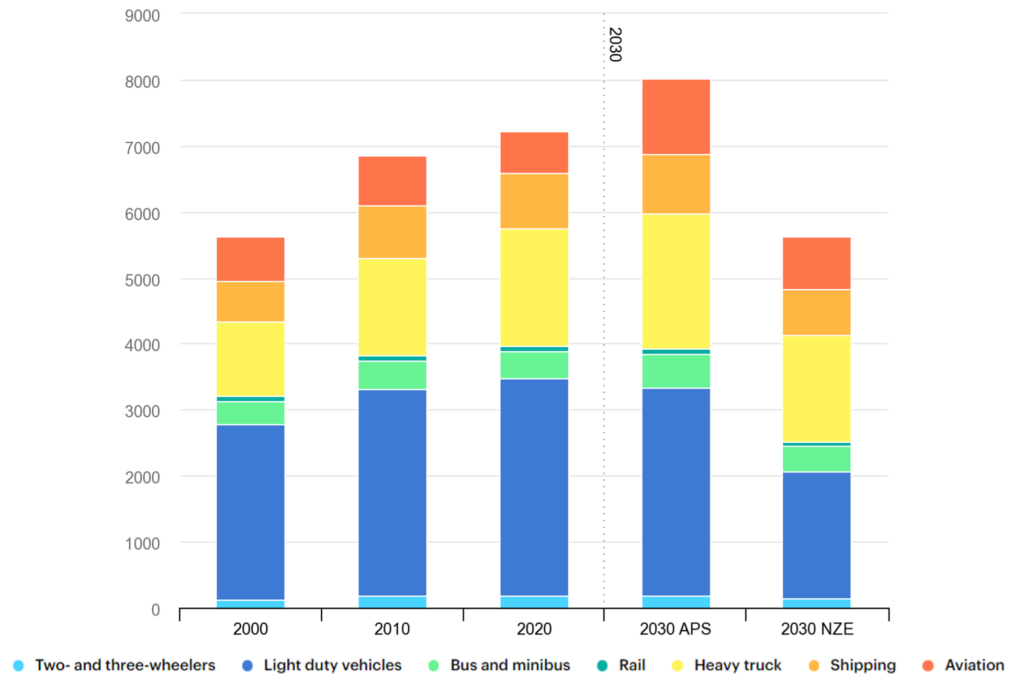Whereas electrical automobiles (EVs) quickly eat up gross sales of latest privately-owned automobiles, the mobility companies sector (together with ride-hailing, automotive sharing, automotive leasing and automotive subscriptions), can be being disrupted by battery-powered automobiles. EVs are stimulating entrance of sustainability-focused newcomers into the mobility companies business, and these new, revolutionary, and EV-focused enterprise fashions are serving to to get extra drivers and riders into EVs.
Market Drivers
Practically half of world transportation CO2 emissions come from on-road two- and three-wheeled automobiles and light-weight responsibility automobiles. To fight these emissions, governments around the globe have set targets to ban new gross sales and registrations of inside combustion engine (ICE) automobiles by 2050 (on the newest) and transition to electrical automobiles (EVs). In truth, EVs of every type are already displacing 1.5 million barrels of day by day oil demand.
Automobiles in mobility service fleets have gotten an more and more essential piece of the decarbonization puzzle. The variety of automobiles in ride-hailing fleets alone is predicted to almost double to 35 million by 2025 from 18 million in 2020.

Along with ICE automobile gross sales bans, regulators are starting to stress mobility service suppliers to impress. Low emission zones (LEZs) in areas akin to London, Oslo, Portugal, Italy, Germany and others, are forcing mobility service suppliers to undertake low-emission automobiles to take care of licenses to function in city areas. Different regulatory our bodies are additionally starting to focus on mobility service suppliers in emissions discount requirements, most notably the California Air Assets Board (CARB)’s Clear Miles Commonplace that targets 90% of ride-hailing miles traveled in California to happen in zero-emission automobiles by 2030.
Mobility service suppliers are additionally making their very own commitments to scale back emissions. Lyft and Go-Jek plan to have emissions-free operations by 2030 and Uber has dedicated to internet zero emissions by 2040. On the automotive leasing aspect, Europcar has made a pledge to make 20% of the corporate’s fleet electrical or low-emission hybrid by 2024.
Key Developments and Dynamics
The falling value of batteries, the rising variety of out there fashions and growing vary are making EVs extra appropriate for mobility companies. The push to impress will considerably disrupt the mobility companies sector within the coming decade, catalyzing new enterprise fashions and expertise innovation.
EV-focused corporations are rewriting the ride-hailing playbook
Experience-hailing innovators are adopting asset-heavy enterprise fashions that embody automobile possession and full-time, salaried drivers. As a result of decrease per-mile working value of EVs, corporations that personal the automobiles can maximize value financial savings and extra shortly scale an EV fleet than asset-light enterprise fashions that depend on contracted drivers to purchase or lease their very own EVs.
Some incumbent mobility service suppliers, significantly ride-hailing suppliers, are increasing into multi-modal choices by including electrical bikes, scooters and mopeds to their platforms. For instance, Revel, an EV ridesharing and electrical moped sharing platform and operator of EV charging hubs, raised $126 million earlier this 12 months to develop its publicly-available common quick EV charging community and all-Tesla electrical ridesharing service. Due to the excessive variety of miles pushed, ride-hailing drivers see larger relative gas financial savings and shorter payback intervals for electrical automobiles than personal automobile house owners.
Automotive subscriptions are breaking down the boundaries to get drivers into EVs
The automotive subscription mannequin is turning into extra engaging for these interested in EVs however not prepared or in a position to purchase one outright. Provide chain challenges have created prolonged wait instances for a lot of EVs – presently, the wait time for a brand new Tesla (all fashions) is anyplace from a number of months to almost a 12 months. With a subscription, nevertheless, drivers can begin driving an EV whereas they wait for his or her new one to reach. It is usually a method to study extra about EVs (how and the place to cost, upkeep necessities, and so on.) and if they may match into one’s life-style (i.e., adequate vary and entry to charging for driving habits) earlier than committing to a purchase order.
A number of corporations on this house are gaining traction. Alto, a Texas-based supplier of on-demand passenger experience companies, raised a $45 million Sequence B in 2021 to triple their geographic service space and start the transition to a totally electrical fleet, with a objective of getting a 100% electrical fleet of three,000 automobiles by the tip of 2023. Ferry, an EV subscription platform primarily based in Texas, raised $4 million in Seed funding in February to develop this enterprise mannequin within the U.S. Onto, a UK-based supplier of full-service EV subscriptions, lately raised $60 million in Sequence C funding to develop to Germany.
Challenges
A number of boundaries exist to electrifying mobility companies. Primarily, EVs are dearer to buy, lease or subscribe to than gas-powered automobiles. In accordance with Kelley Blue Ebook, the common transaction value for an EV was over $56,000 in November 2021, which is $10,000 larger than the typical for all the business. Nevertheless, declining battery prices and excessive manufacturing scale might assist BEVs attain the identical pre-tax retail value as ICE automobiles between 2025 and 2027, in response to some research. Though it is a problem for the businesses buying or leasing EVs for their very own fleets, it is usually enabling revolutionary enterprise fashions, such because the automotive subscription and as-a-service mannequin, to assist get shoppers into EVs and not using a down fee or mortgage.

Picture 2: Common transaction costs for automobiles in 2021. Supply: Kelley Blue Ebook
Second, public charging infrastructure is extraordinarily variable by area and the time it takes to cost presents a possibility value for producing income or utilizing the automobile for transport. At the moment, most mobility service drivers depend on current public and residential charging infrastructure. As well as, information of how and the place to cost remains to be restricted for drivers and riders new to EVs. Varied enterprise fashions are being examined and trialed to provide drivers handy entry to quick charging. One instance is Onto’s partnerships with BP, Shell, Tesla Superchargers and InstaVolt. For an extra month-to-month charge on high of the automobile subscription, drivers can have entry to those networks for no extra value on the plug.
Experience-hailing innovators which can be adopting asset-heavy enterprise fashions might wrestle to satisfy buyer expectations. Due to their asset-light mannequin, the likes of Uber and Lyft have outsized fleets that enable them to supply on-demand pick-ups wherever the rider is. Not less than within the close to time period, asset-heavy corporations might not be capable to present the identical service pace as clients have come to anticipate on account of having fewer automobiles and drivers. As well as, these corporations might want to maximize asset utilization to make the enterprise case work.
What to Watch For
Be careful for incumbents coming into extra partnerships alongside the worth chain, akin to with charging suppliers (e.g., Uber partnership with Ample, Onto partnership with Shell) and automakers, and strategic acquisitions of rivals and complementary expertise suppliers which can point out market maturity. Rising numbers of EVs in fleets and expansions of EV choices by incumbents are key milestones in direction of large-scale electrification. Search for extra innovation in charging, fleet administration and associated companies to maximise automobile utilization and unlock scale. Additionally look out for extra regulators particularly concentrating on mobility service suppliers, in a similar way to CARB’s Clear Miles Commonplace, that can speed up electrification, particularly if funding is made out there to subsidize EV purchases. Lastly, macro-economic components, akin to inflation and ongoing provide chain challenges are inflicting excessive sticker costs and lengthy wait instances for brand new automobiles. If these traits proceed, shoppers might go for entry to automobiles (reasonably than outright possession), accelerating development of mobility companies total.
